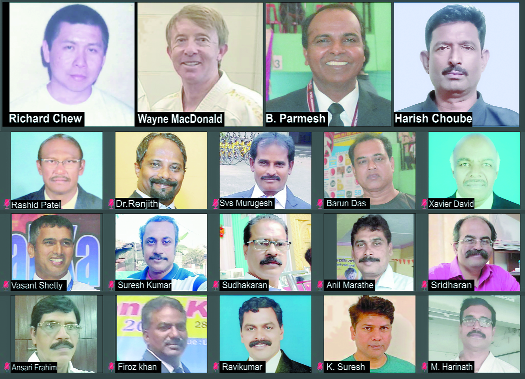Traditional karate is about self-defence and survival, says Kyoshi Choube
| Date :22-May-2021 |

“Traditional karate is the original karate. It came into existence as a fighting art in Okinawa, Japan. The original karate has its roots in ‘Tode’, a weaponless self-defence system,” said Kyoshi Harish Choube, National Chief, Instructor and Examiner Karate Budokan International and Sports Coordinator.
Choube was speaking during the 36th session of online Karate and Sports Seminar for Physical and Spiritual Development of Sportspersons.
The webinar is being organised by Karate Budokan International (Vidarbha Region).
Choube informed in detail about the history of Karate Budokan International and difference between traditional karate and sports karate.
He said Grandmaster Chew Choo Soot, the inventor of the sport, had the vision and turned his ‘Karate Style Club’ into one of the leading clubs in the world.
Speaking about the history of Karate Budokan International (KBI) which started from Malaysia and moved to it’s modern day presence in over a dozen countries, Choube said the federation is 52 years old.
“KBI started in a small 1st floor shop in Petaaling by Chew Choo Soot. The first course offered to the public was ‘Karate Jodo Self-Defence’ which enabled students to defend themselves under normal circumstance. The headquater, which came into existence in on May 26, 1968, is situated at Loke Yew road Kaula Lumpur. Encik Mohd Khir Jhohiri, the then education minister of Malaysia headed the body,” said Choube.
“Chew then trained many young aspiring karatekas since then. After his passing away of Chew at the age of 76 in 1997, Richard Chew became a Grand Master of Karate Budoan International. Wayne MacDonald was appointed as a International Chief Instructor of Karate Budokan International and Hanshi B Parmesh as the Asia Chief Instructor of Karate Budokan International,” informed Choube.
Choube claimed that KBI has the largest membership in the world. He added that KBI is the largest and most active karate organisation in India.
Speaking about the difference between traditional karate and sports karate, Choube said, “traditional karate is the original karate. It came into existence as a fighting art in Okinawa, Japan. The original karate has its roots in ‘Tode’, a weaponless self-defence system. It is influenced by Chinese martial arts and has a history that’s over two thousand years old. On the other hand, sport karate descended from traditional karate. The techniques of this art are based on the stances on punches and kicks of the Japanese karate, but were adapted to be more competitive,” he said.
Speaking about the objective and purpose of karate, Choube said, “The objective behind traditional karate is self-defence and survival. It is based on the concept of ‘finishing blow’, meaning the last blow of the fight that is sufficient to render the attacking opponent unconscious, unable to fight.
“In traditional karate competitions, the point is awarded to the person who punches the finishing blow. The purpose of this fighting technique is to develop well-balanced mind and body through training,” the Sports Coordinator said.
“Sport karate is more about competition and scoring points. The points are awarded to the fastest and the most precise hit on the target with a foot or fist, so there is no need for the finishing blow. The purpose is to cultivate the fighting spirit and win the battle,” Choube elaborated on the scoring system of the game.
“In traditional karate schools, hardwood floors and negligible fixtures are inspired by the conventional karate teachings found in Japanese dojos. Whereas sport karate classes are conducted in a modern set-up where mats replace hard wood floors. Matted floors are installed to provide a safer environment, especially for children. Big, wall-sized mirrors are placed to give a studio-like appearance,” Choube said about the difference in the traditional and sport karate forms.
Speaking about the categories and competitive events in two forms of karate, Choube said, “In traditional karate competition, the weight and height of the opponent don’t matter. The aim is to unite the body’s power into a single blow (finishing blow). In a sport karate competition, there’s weight categories established. There are eight different weight categories,” he mentioned.
Choube said that traditional karate is a lifetime study. In this form of karate, one practices techniques repeatedly to perfect them. The techniques are crisp, showing power and control over the body. “In sport karate, the techniques are more fluid and reactive, designed for modern-day combat. Sometimes, other techniques are also adapted to make the students learn the most effective way of self-defence,” he explained.
To put it simply, traditional karate is an art, whereas sport karate is a sports event.
The webinar concluded with interactive sessions.
Renshi Karunkumar Tirpude, Karate Budokan International, proposed a vote of thanks.